A catalogue dated August 1st 1882 shows further developments and
is the first indication of the export trade which was to become
so important to the firm.
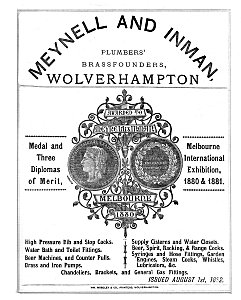 |
The front page of the catalogue shows the medal, and
mentions the three diplomas, awarded to Meynell & Inman at the
Melbourne International Exhibition of 1880.
This exhibition
attracted 13,000 exhibitors to Melbourne (a city which had only been
founded fifty years before) and it, and Sydney exhibition of 1879,
put Australia firmly on the world's commercial map.
Meynell &
Inman would have been glad to have made the enormous effort to get
there and to have come away with some recognition. |
| The range of products in the catalogue is much as
before but this is the first surviving catalogue in which gas
brackets ("glasses charged extra") appear. |
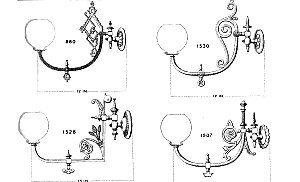 |
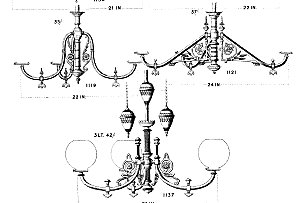 |
It is also the first surviving catalogue in which chandeliers ("glasses charged
extra") are illustrated. |
In 1884, the Wolverhampton and
Staffordshire Fine Arts and Industrial Exhibition was held in the newly
opened Art Gallery and in temporary buildings erected for the purpose on
the nearby market patch.
| Meynell’s do not seem to have exhibited (because
they were so close to the Exhibition) but they had this full page
advert in the catalogue.
They are still called Meynell & Inman of Montrose Street
(“three minutes walk from Exhibition Art Gallery”).
Amongst the exhibitors we find:
“Messrs Ready & Son, Wolverhampton.
Chandeliers, gas fittings, beer pumps, garden engines,
etc..”, which suggests that Ready had left to set up his own
business with a very similar range of products.
In this advertisement Meynell and Inman describe themselves as
“Manufacturers of all sorts of fittings for gas, steam, water
and beer” and the advert shows taps, flushing toilets, plumbers
brassfoundry, hose fittings and chandeliers.
|
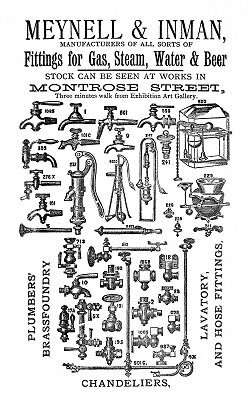 |
In 1884 Captain Inman retired and the firm was restyled
Meynell and Sons.
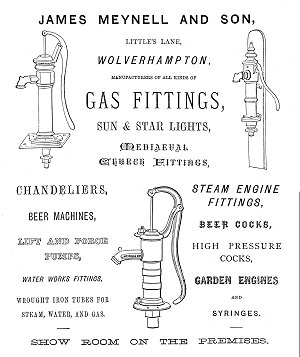 |
In 1887 an advertisement in Steen and Blackett’s Guide
to Wolverhampton shows the firm as James Meynell and Son, and
gives their address as Little’s Lane.
Perhaps by this time the company had expanded from
Montrose Street into Little’s Lane, which runs parallel with it.
Certainly Inman has dropped out of the picture.
The advert shows pumps, which were now becoming an
important part of their trade. It also lists “gas fittings, sun
and star lights, medieval church fittings, chandeliers, lift and
force pumps, water works fittings, wrought iron tubes for steam,
water and gas, steam engine fittings, beer cocks, high pressure
cocks, garden engines and syringes”.
|
Later market requirements covered the Gas Age when amongst many other
gas fittings the Company specialised in making the lamplighter's lighter
which was a long pole with a small flame at the top which was taken
around by a cyclist to light street gas lamps.
| Chandeliers were one of their main products at this
time.
The firm made the chandelier for the auditorium of the Grand
Theatre when it opened in 1894.
Photo by courtesy of the Grand Theatre, Wolverhampton. |
 |
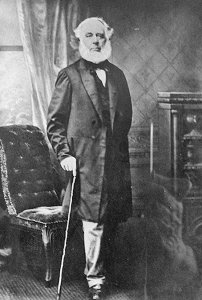 |
James Meynell had lead the company from its
foundation, through various partnerships and through the most hectic
years of the Industrial Revolution. He had kept the company in
line with modern developments and had established it in the export
trade. |
| James was succeeded by his son, Edward James Meynell
(1826 – 1900).
There is a blue plaque to him in Queen Street, near to where he
was born. |
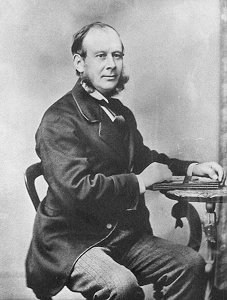 |
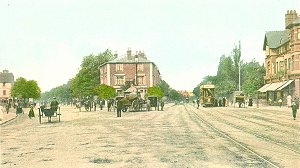 |
He lived in Granville House, at the end of Chapel
Ash, between Tettenhall Road and Compton Road. |
|
The next in line was Herbert Meynell.
He started work at the age of 16.
As he entered the works for the first time he met the office
furniture being carried down the stairs.
He was told it was being sold off to pay his father’s debts.
His father was a betting man. One year he took his family,
by horse and carriage, for their usual month's holiday at Colwyn
Bay. Whilst there he placed a bet on an outsider at long
odds for the huge sum of 10 shillings - approximately one week's
salary. The horse won - whereupon Edward sent a letter to
his son, Herbert, telling him that he would be staying at Colwyn
Bay for an extra month. |
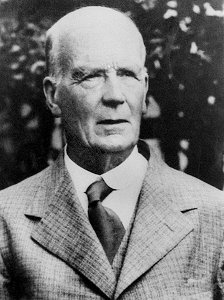 |
But life had not been all
betting and holidays. Edwards's daughter, Gladys, recollected
going on a sales trip round Norfolk and Lincolnshire and the first calls
were made on the customer's doorstep at 6.00 a.m.. So it was Herbert who brought the company round and
died in harness, having been with the company for 71 years.
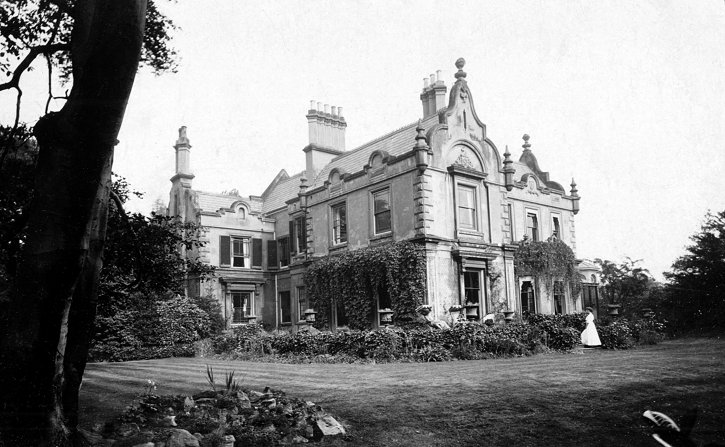
He lived in
Oakfield, Oaks Crescent, which was later,
partly
turned into flats then sold off and demolished in the 1960s. In the
1920s and 1930s a block of shops and the former Charles Clark car
showroom were built in the grounds. I must thank David Clare for the
photo and the information about the house. |
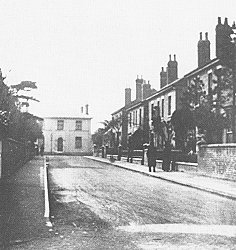 |
Herbert Meynell then moved to Eagle House in
Eagle Street. Eagle House is
seen at the far end of the street in the left-hand photo.
There
were eagles on the gate piers to the right of the house. |
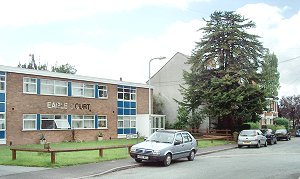
The site of Eagle
House is now occupied by Eagle Court. |
Herbert took over at about
the time of the Boer War. That war
conjures up all sorts of memories for the connoisseur, with old fashioned
cavalry charges and fine multi-coloured uniforms. One of the elite regiments in the British Army was the Camel
Corps and they were equipped with small portable fire extinguishers
which were clipped on to the saddles alongside and vertically adjacent
to the rider’s log. This
called for a specially designed unit which was produced by the Meynell
Company and was based on their pump mechanisms originally designed for
pulling beer. It is more than likely that the British Army warriors on
their camels would have wished, many times, in the midst of the desert
heat, that they could have used their fire extinguisher to produce some
beer.
|

